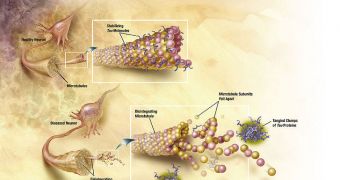A group of investigators in the United States announces the discovery of a new molecular mechanism, that may be responsible for how neurons are destroyed in Alzheimer’s and other forms of dementia.
In this spectrum of conditions, brain cells called neurons are destroyed, and researchers have been wondering as to the exact nature of the mechanisms at work in doing so for many years.
One of the things they knew is that a small peptide called beta amyloid is needed to destroy the neurons. A great deal of work has been put into developing new treatments based on this molecule.
At the same time, the tau protein has also been studied extensively for the past three decades or so. Experts say that it too plays a significant role in the development of various forms of dementia.
In genetic studies, it has been demonstrated that the two molecules somehow work together to kill off neurons. Until now however, experts had no idea what the connection was. The studies have also revealed that beta amyloid modifies tau in a new way.
Recently, experts with the University of California in Santa Barbara (UCSB) managed to identify how the two molecules interact to destroy nerve cells. “With dementia, the brain cells, or neurons, that you need for cognitive skills are no longer working properly,” says Stuart Feinstein, PhD.
“Then, they’re not even there anymore because they die. That’s what leads to dementia; you’re losing neuronal capacity,” says the expert, who is the senior author of the new study, and also the co-director of the UCSB Neuroscience Research Institute.
“We know amyloid beta is a bad guy. Amyloid beta causes disease; amyloid beta causes Alzheimer’s. The question is how does it do it?” he says. In the new study, Feinstein and his team managed to discover that beta amyloid is rendering tau incapable of performing its true function.
The tau protein has numerous functions inside the body, but the most important one is to stabilize vital parts of the cellular cytoskeleton called microtubules. These structures play an important role in controlling several aspects related to the function and structure of neurons.
One of the things that separate nerve cells from other types of cells is the fact that they have extremely long sections called axons, which contribute to creating neural networks, allowing each individual neuron to be connected to up to 10,000 other nerve cells.
In the new lab studies, when tau was exposed to beta amyloid, the former began to fragment as early as 60 to 120 minutes after exposure. Less than 24 hours later, the exposed cells were destroyed. This is what happens in dementia as well.
“If you destroy tau, which is an important regulator of the microtubules, one could easily see how that could also cause cell death,” Feinstein explains. The new study appears in the latest online version of the esteemed Journal of Biological Chemistry.
“We know from cancer drugs that if you treat cells with drugs that disrupt the cytoskeleton, the cells die. In my mind, the same thing could be happening here,” the expert ads, quoted by PsychCentral.

 14 DAY TRIAL //
14 DAY TRIAL //